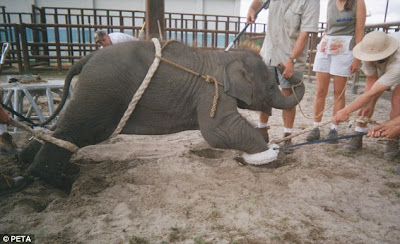 see you: A Mie University image shows a goldfish whose beating heart can be seen through translucent scales and skin in Tsu city, central Japan
see you: A Mie University image shows a goldfish whose beating heart can be seen through translucent scales and skin in Tsu city, central Japan First came see-through frogs. Now Japanese researchers have succeeded in producing goldfish whose beating hearts can be seen through translucent scales and skin.
The transparent creatures are part of efforts to reduce the need for dissections, which have become increasingly controversial, particularly in schools.
'You can see a live heart and other organs because the scales and skin have no pigments,' said Yutaka Tamaru, an associate professor in the department of life science at Mie University.
'You don't have to cut it open. You can see a tiny brain above the goldfish's black eyes.'
The joint team of researchers at Mie University and Nagoya University in central Japan produced the 'ryukin' goldfish by picking mutant hatchery goldfish with pale skin and breeding them together.
'Having a pale colour is a disadvantage for goldfish in an aquarium but it's good to see how organs sit in a body three-dimensionally,' Tamaru said.
The fish are expected to live up to roughly 20 years. They could grow as long as 25cm (10in) and weigh more than 2kg (5lb), much bigger than other fish used in experiments, such as zebrafish and Japanese medaka, Tamaru said.
'As this goldfish grows bigger, you can watch its whole life,' he said.
Meanwhile another group of researchers, who announced in 2007 they had developed see-through frogs, said they planned to start selling the four-legged creatures, whose skin is transparent from the tadpole stage.
 Transparency: Yutaka Tamaru, an associate biology professor at Mie University, and his team have succeeded in producing the transparent goldfish, which is part of efforts to reduce the need for laboratory dissections
Transparency: Yutaka Tamaru, an associate biology professor at Mie University, and his team have succeeded in producing the transparent goldfish, which is part of efforts to reduce the need for laboratory dissections'We are making progress in their mass-production. They are likely to be put on the market next year,' said Masayuki Sumida, professor at the Institute for Amphibian Biology of Hiroshima University.
Sumida said see-through tadpoles and adult frogs would be available in the first half of next year in Japan for laboratories and schools and as pets, with a price tag expected to be below 10,000 yen (£70) each.
He also wants to sell the creature abroad.
Animal rights activists have pressed for humane alternatives to dissections, such as using computer simulations.
Sumida's team produced the creature from rare mutants of the Japanese brown frog, or Rena japonica, whose backs are usually ochre or brown. Two kinds of recessive genes have been known to cause the frog to be pale.
While goldfish are easier to keep, frogs are higher forms of life and therefore preferable for experiments, Sumida said.
source: dailymail














++1.jpg)
















































